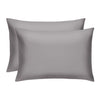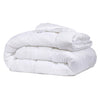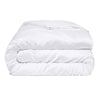The Daily Miracle
How To Remove Yellow Stains From White Clothes
Published
September 27, 2023
Author
Bridget Reed

Yellow stains on white clothes can be as mysterious as they are frustrating. Whether it's that dazzling white dress shirt or a cherished t-shirt, maintaining their pristine appearance is often a battle. If you’re not sure how to keep your whites vibrant and clean — whether you’re worried about clothes, towels, or even bedding — don’t worry.
It's time to turn science into your ally. And in the world of whites, knowing your enemy is half the battle. In the upcoming sections, we'll delve into the reasons behind these stains and explore scientifically-backed techniques to get rid of them.
Identifying the Culprit
Stain removal begins by identifying the source. Sometimes, how you approach a stain may vary depending on the culprit.
One of the most common perpetrators is sweat stains. Surprisingly, it's not merely the sweat itself causing the yellowing. Body sweat is a concoction of proteins and salts that can react with aluminum-based compounds often found in deodorants.
This reaction forms a yellowish residue that binds with the fabric, causing those unsightly discolorations. Another common cause of yellowing is food or drink, which can be tricky.
These substances don't merely sit on the surface but bind with the fabric's fibers. This creates stubborn stains that refuse to budge when they’re not immediately cleaned, challenging even the most diligent cleaners.
White clothes' susceptibility to yellowing is not limited to external factors like sweat or food. The very process of aging can turn once-pristine white fabrics into a dingy shade of yellow. The cause might be as simple as a reaction with bleach or other whitening agents over time. This process is exacerbated by other factors like sunlight, which speeds up the yellowing.
Now that you have an idea of where your yellowing whites may have gone wrong, let’s talk about how to fix it.
Tried-and-True Techniques
Equipped with science and determination, you're ready to use several methods that turn common household items into powerful stain fighters.
Vinegar
Vinegar is a versatile solution that has been a household favorite for centuries. The secret behind its effectiveness lies in its acetic acid content, which breaks down the stain on a molecular level.
Vinegar is surprisingly gentle on fabrics, making it an excellent option for delicate items like lace or silk. A soak or a targeted application can turn that yellow blight into a mere memory.
Baking Soda
No longer confined to baking, this common kitchen ingredient has emerged as a multi-tasking champion in stain removal. Mixing it with a bit of water to create a paste and applying it to the stain allows the sodium bicarbonate to react with the substances that caused the discoloration. The gentle abrasive quality can lift the stain without harming the fabric, an elegant solution that's often just a pantry away.
Hydrogen Peroxide
For old or set-in stains, hydrogen peroxide is like the cavalry arriving just in time. It acts as a mild bleach, breaking down stains and restoring whiteness without the harshness of stronger bleaching agents.
However, it's not without its risks. It's excellent for whites but should be used cautiously on colored fabrics. A wrong move with hydrogen peroxide could leave you with a different sort of stain, so knowledge and care are vital here.
Dish Soap (and Vinegar)
Some stains are more resistant, like the ones from salad dressings or greasy food. Here, a blend of dish soap and vinegar can break down oily stains.
The soap targets the grease, while the vinegar works on the coloration. Together, they form a dynamic duo, able to tackle even the most stubborn oily marks.
Sunlight
Nature’s bleach, sunlight, can often help in the stain removal process. Leaving the stained garment out in the sun after applying a treatment can enhance the stain-lifting power of these natural methods.
Lemon Juice
For a citrusy approach, lemon juice can also prove effective. Its natural acidity can break down stains, and it adds a fresh scent to the process. It's like a little zest in your stain-fighting regimen.
Step-by-Step Stain Removal Guide
1. Identify the Fabric and Its Needs
The first task at hand is to identify the fabric. Fabrics vary in their makeup, and thus, how you approach them must also differ. Delicate fabrics like silk or wool require a gentle and nuanced touch, while sturdier cotton can withstand a more robust cleaning.
2. Choose the Best Stain-Buster
Once you've discerned the fabric, it's time to choose your stain-fighting technique. Here's where the previously discovered knowledge of the stain type becomes crucial. Matching the removal method with the stain's nature and fabric ensures you're on the right path.
Tougher stains demand special attention. Pre-treating the stain with a specific stain remover or soaking the fabric can soften it, rendering it more susceptible to removal. The pre-treatment process might include soaking in cold water for protein-based stains or hot water for oily stains, always considering the fabric's care instructions.
3. Patch Test First
Moving forward, testing a small, hidden area is wise. Applying the chosen method to an inconspicuous part of the garment ensures that the fabric doesn't react adversely to the treatment. This step, though often overlooked, can save your cherished piece from unintended damage.
4. Scrub Your Stain
Next comes the hands-on part — applying and scrubbing. Depending on the stain and fabric, gentle scrubbing using a soft toothbrush, sponge, or cloth can work wonders.
The motion should be consistent, starting from the outside of the stain and working inward to prevent spreading. Patience here is key, as rigorous scrubbing can harm the fabric, while mild, consistent rubbing often does the trick.
5. Wash and Dry As Normal
Once satisfied with the stain's removal, it's time to wash and dry the garment. Following the garment's washing instructions, it's often best to wash it separately to prevent any lingering stain from transferring to other clothes. You’ll want to use a gentle yet powerful detergent to remove any lingering pigment.
Our Laundry Sheets are an easy solution. They’re eco-friendly and gentle on your skin while still providing extra strong cleaning power to give your fabrics a deep clean that leaves no trace of your strains.
Air drying, when possible, is often preferable as it helps to avoid heat setting any remnants of the stain that might remain. You can even leave your item, whether it’s a shirt or your bedding, to air dry in the sun, which can help mellow any remaining yellow.
6. Repeat As Needed
The final step in this thorough process might be a repetition of the earlier stages if the stain proves particularly stubborn. Repeating the process ensures that you have taken every opportunity to eradicate the stain without harming the garment.
A Clean Sweep
Stains, once a source of dread, need not be any longer. With an understanding of the underlying science and an array of tools at your disposal, yellow stains on white clothes are now merely a temporary inconvenience.
Whether using kitchen staples like vinegar or understanding the chemistry behind each stain, you now possess the know-how to maintain the brilliance of your whites. It’s great knowledge to have, and will remove tons of stress from your life to know that whatever life throws at your favorite clothes (often literally), you’ll be able to keep them as bright and white as they were the day you got them.
Sources:




















